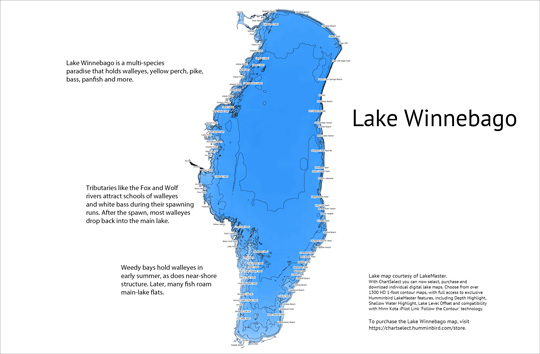Lake Winnebago, WI: Walleye Factory
The largest of Wisconsin’s inland waters, Lake Winnebago is part of a chain that includes lakes Poygan, Winneconne, and Butte des Morts. Although the big lake covers nearly 132,000 acres over three counties, it is quite shallow, with a maximum depth of just 21 feet.
The lake’s extreme characteristics make it a perfect environment for gamefish—large- and smallmouth bass, pike, catfish, muskies, yellow perch, and especially walleyes. Winnebago’s expansive shallow, fertile waters combined with outstanding spawning areas in the upstream lakes make the lake system a genuine walleye factory and a premier destination for walleye anglers everywhere.
Fishermen with limited experience on the big lake often find that locating walleyes can be challenging, however, because the sprawling main-lake area is relatively featureless. Predator fish follow nomadic forage species and are ever on the move. Once a school is located, it’s typical to find it in the same general area the next day. Making initial contact, though, takes some effort.
Adam Rasmussen has spent the past 12 years guiding open-water and ice anglers to walleyes, perch, pike, crappies, and white bass on Winnebago and area lakes and rivers. Being on the ice on a daily basis helps him keep in contact with walleyes, but if you’re going out cold, his advice is to stay mobile.
“Pick a spot on the map and fish it for no more than 5 or 10 minutes,” he says. “If you don’t see walleye on the sonar in that time, pick a direction and move a quarter-mile. Keep doing that until you find them.”
Marking a few walleyes on sonar indicates that you’re on the edge of the school, he explains, and that’s when it’s time to make shorter jumps. “Move 100 or 200 yards at a time and don’t stop until you see them stacked under the ice.”
Another tactic is to start before sunup and pinpoint fish along the bases of reefs along the east and west shorelines. As the sun rises, the walleye will move back toward mid-lake, “and that’s when you have to chase them,” he says.
Walleyes are generally aggressive and will hit an untipped bait, according to the guide. His preferences are a 1/16- or 1/8-ounce Buck-Shot Flutter Spoon, 1/16- or 1/12-ounce Macho Minnow, and a 1/8- or ¼-ounce Puppet Minnow—natural metallic in clear water; a bright finish in dirty water.
“It’s a game of cat and mouse,” he says. “You have to chase ‘em, and then get ‘em to take the bait.”
During the late winter and springtime, many Winnebago walleyes migrate up the incoming Fox River and other tributaries, offering fine fishing throughout the spawning period. After that, many fish work their way back down into the main lake, often holding on near-shore reefs before moving offshore. In the early summer, the lake’s lush shoreline weedbeds can also hold good numbers of walleyes for anglers willing to pitch a jig tipped with a minnow or soft-plastic trailer.
With ChartSelect you can now select, purchase and download individual digital lake maps. Choose from over 1300 HD 1-foot contour maps, with full access to exclusive Humminbird LakeMaster features, including Depth Highlight, Shallow Water Highlight, Lake Level Offset, and compatibility with Minn Kota iPilot Link ‘Follow the Contour’ technology.
To purchase the Lake Winnebago map in its entirety.


